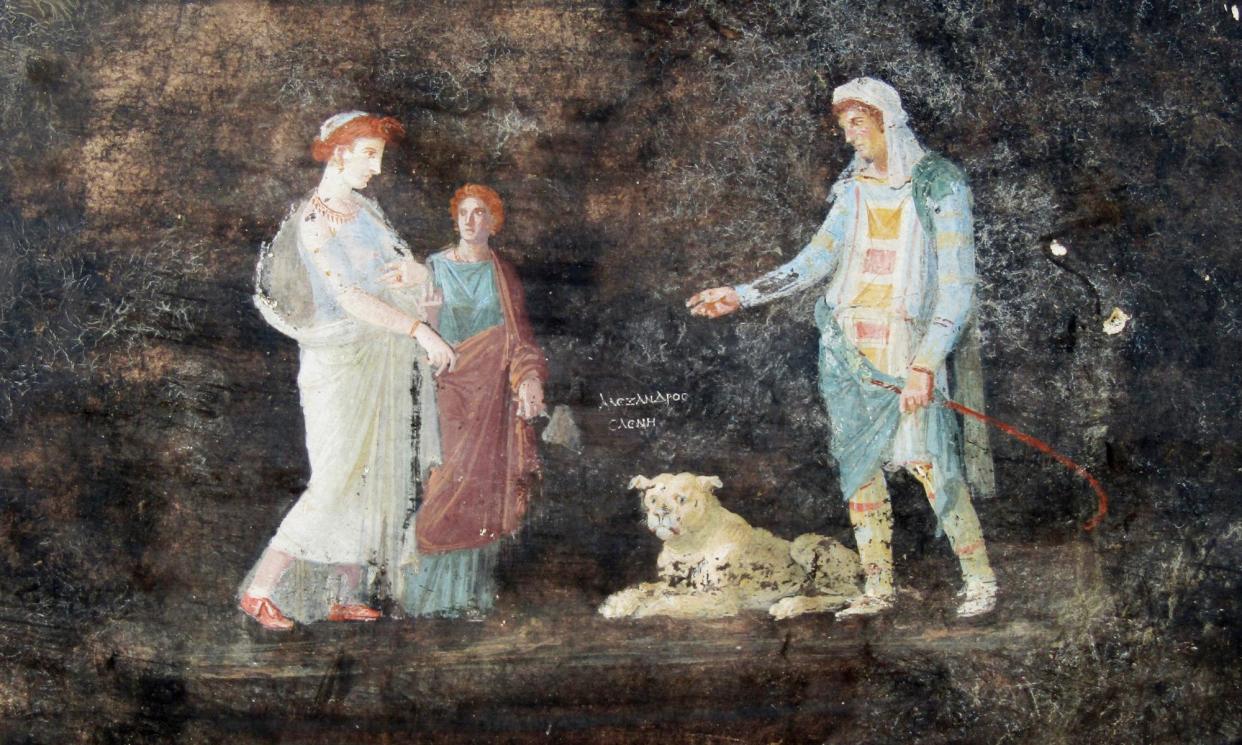Banquet room with preserved frescoes unearthed among Pompeii ruins

A banquet room replete with well preserved frescoes depicting characters inspired by the Trojan war has been unearthed among the ruins of Pompeii in what has been described as one of the most striking discoveries ever made at the southern Italy archaeological site.
The 15-metre-long, six-metre-wide room was found in a former private residence in Via di Nola, which was ancient Pompeii’s longest road, during excavations in the Regio IX area of the site.
The “black room”, so-called because of the colour of its walls that were probably intended to mask the soot from burning oil lamps, was a “refined setting for entertaining during convivial moments”, experts said.
Its walls are adorned with artworks featuring mythical Greek characters, including one of Helen of Troy meeting Paris, prince of Troy, for the first time. The fresco includes a dog and a Greek inscription that reads “Alexandros”, the prince’s other name. According to Greek legend, the pair’s elopement triggered the Trojan war in the 12th century BC.
Another fresco depicts the Greek god Apollo trying to woo the priestess Cassandra. In his efforts to seduce her, Apollo had bestowed upon her the power to foresee the future, but when she rejected him he cursed her so that nobody would believe her predictions. As a result, she was unable to thwart the tragic events of a battle she had prophesied. After being raped during the capture of Troy, Cassandra ended up enslaved.
Gabriel Zuchtriegel, the director of Pompeii’s archaeological park, said the mythological figures had the explicit function of entertaining guests and providing talking points during feasts.
“The mythological couples provided ideas for conversations about the past, and life, only seemingly of a merely romantic nature,” he said. “In reality, they refer to the relationship between the individual and fate: Cassandra who can see the future but no one believes her, Apollo who sides with the Trojans against the Greek invaders, but being a god, cannot ensure victory, Helen and Paris who, despite their politically incorrect love affair, are the cause of the war, or perhaps merely a pretext.”
He added: “People would meet to dine after sunset; the flickering light of the lamps had the effect of making the images appear to move, especially after a few glasses of good Campanian wine.”
The artworks are “third style”, or ornate style, and dated between 15BC and AD40-50.
“It’s always difficult to judge quality but what we see is a high degree of care for detail, expression and shadows,” said Zuchtriegel. “This is very striking, as is the topic of the works.”
Meanwhile, the room’s sophisticated mosaic floor contains more than a million tiny white tiles.
The room opens on to a courtyard with a long staircase leading up to the property’s first floor, beneath which a huge pile of building materials was found. On the arches of the staircase, someone had drawn in charcoal two pairs of gladiators and what archaeologists said in a statement “appears to be an enormous stylised phallus”.
Related: Archaeologists unearth ‘most shocking example of Roman slavery’ at Pompeii
Excavations in Regio IX, a district of the city that had hosted a cluster of homes and workshops, have yielded plenty of other discoveries since beginning in February last year, including a home containing a cramped bakery where enslaved people were believed to have been imprisoned and exploited to produce bread.
The remains of three victims of the AD79 eruption of Mount Vesuvius were found in one of the bakery’s rooms. A still-life fresco resembling a pizza was also found on a wall in the home’s hallway. In December, 13 Nativity-style statuettes were found in an upright position on what was probably a shelf in the hallway of a home. Archaeologists said the figurines provided evidence of pagan rituals in Pompeii before the city was destroyed by Vesuvius.
“Pompeii is truly a treasure chest that never ceases to surprise us and arouse amazement because, every time we dig, we find something beautiful and significant,” said the Italian culture minister, Gennaro Sangiuliano.
The Pompeii ruins were discovered in the 16th century, with the first excavations beginning in 1748. Pompeii is the second most-visited archaeological site in the world.


